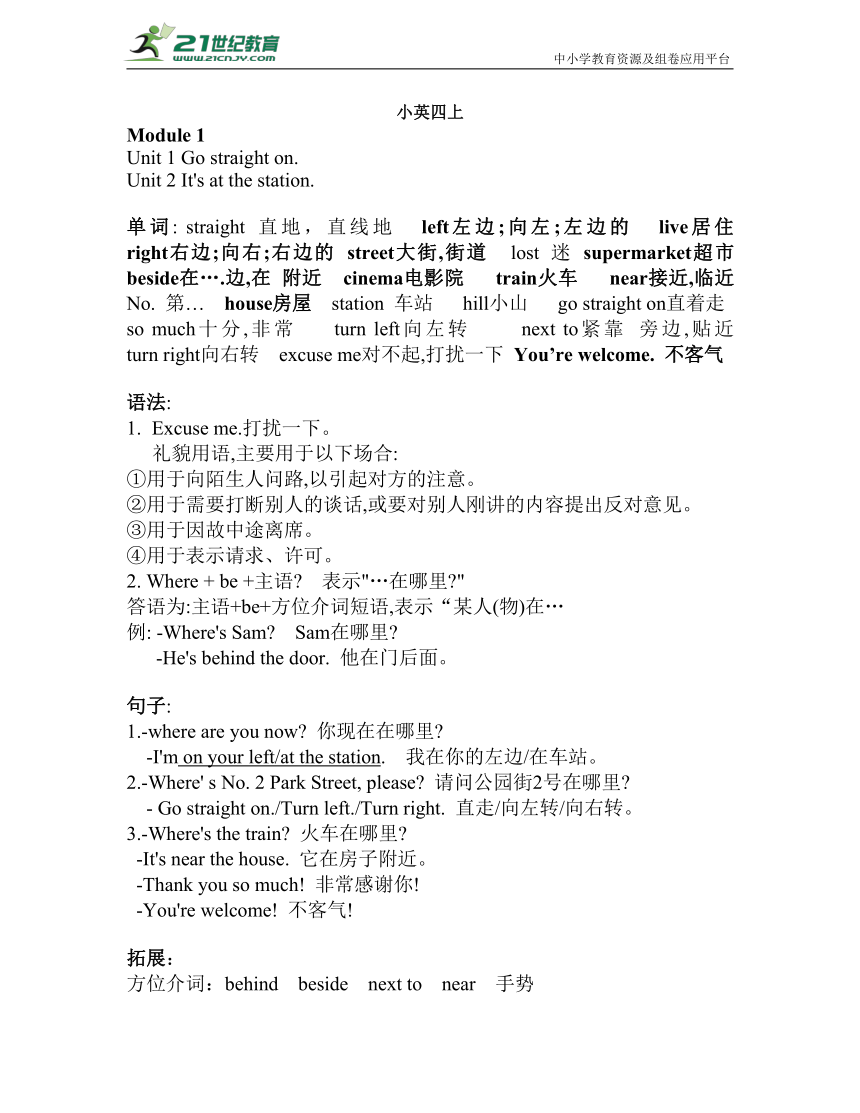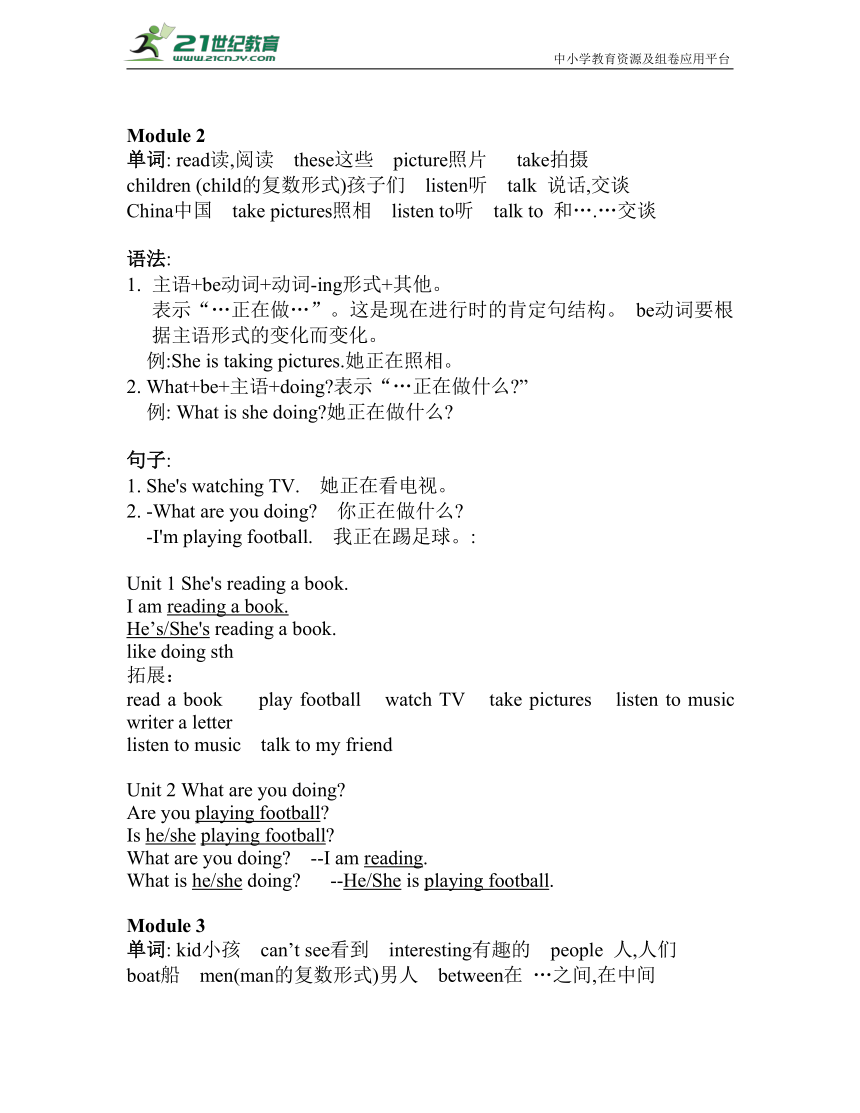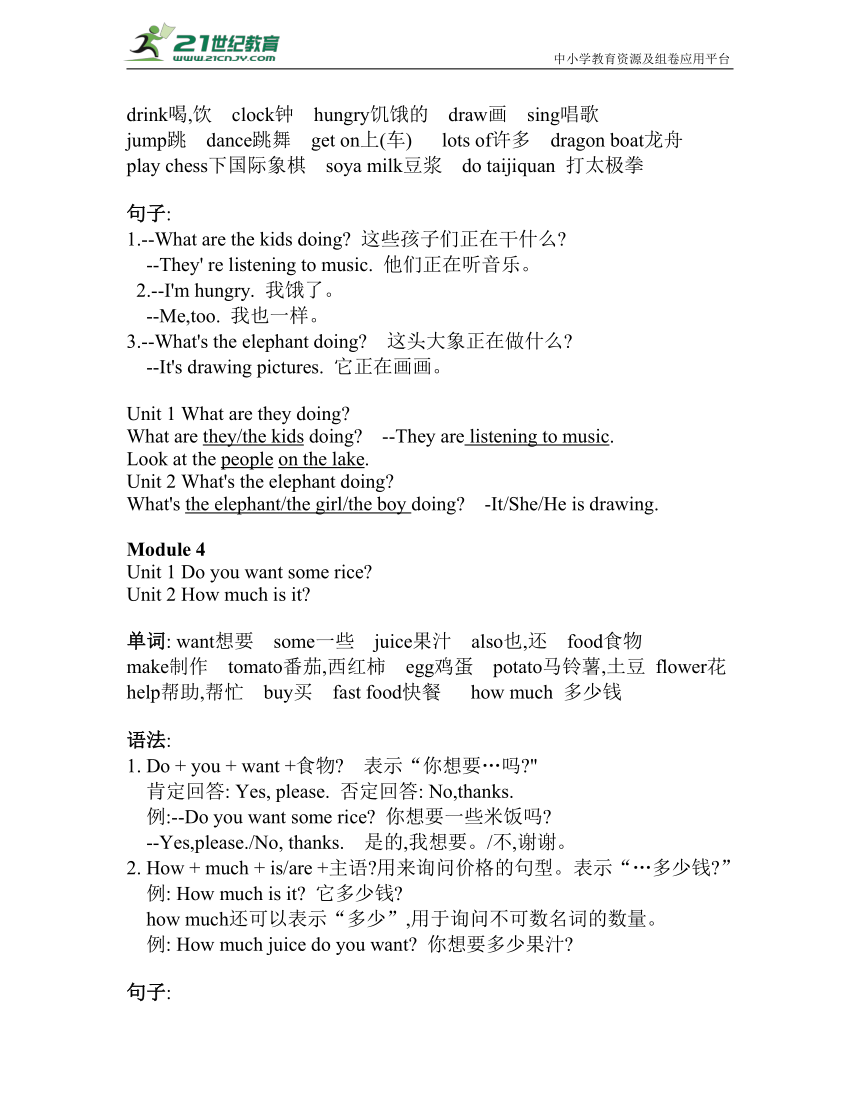外研版(三年级起点)英语四年级上册同步讲义(知识点总结)
文档属性
| 名称 | 外研版(三年级起点)英语四年级上册同步讲义(知识点总结) |  | |
| 格式 | docx | ||
| 文件大小 | 133.0KB | ||
| 资源类型 | 试卷 | ||
| 版本资源 | 外研版(三年级起点) | ||
| 科目 | 英语 | ||
| 更新时间 | 2022-07-11 14:41:41 | ||
图片预览



文档简介
中小学教育资源及组卷应用平台
小英四上
Module 1
Unit 1 Go straight on.
Unit 2 It's at the station.
单词: straight 直地,直线地 left左边;向左;左边的 live居住 right右边;向右;右边的 street大街,街道 lost 迷 supermarket超市 beside在….边,在 附近 cinema电影院 train火车 near接近,临近 No. 第… house房屋 station 车站 hill小山 go straight on直着走
so much十分,非常 turn left向左转 next to紧靠 旁边,贴近 turn right向右转 excuse me对不起,打扰一下 You’re welcome. 不客气
语法:
Excuse me.打扰一下。
礼貌用语,主要用于以下场合:
①用于向陌生人问路,以引起对方的注意。
②用于需要打断别人的谈话,或要对别人刚讲的内容提出反对意见。
③用于因故中途离席。
④用于表示请求、许可。
2. Where + be +主语 表示"…在哪里 "
答语为:主语+be+方位介词短语,表示“某人(物)在…
例: -Where's Sam Sam在哪里
-He's behind the door. 他在门后面。
句子:
1.-where are you now 你现在在哪里
-I'm on your left/at the station. 我在你的左边/在车站。
2.-Where' s No. 2 Park Street, please 请问公园街2号在哪里
- Go straight on./Turn left./Turn right. 直走/向左转/向右转。
3.-Where's the train 火车在哪里
-It's near the house. 它在房子附近。
-Thank you so much! 非常感谢你!
-You're welcome! 不客气!
拓展:
方位介词:behind beside next to near 手势
Module 2
单词: read读,阅读 these这些 picture照片 take拍摄
children (child的复数形式)孩子们 listen听 talk 说话,交谈
China中国 take pictures照相 listen to听 talk to 和….…交谈
语法:
主语+be动词+动词-ing形式+其他。
表示“…正在做…”。这是现在进行时的肯定句结构。 be动词要根据主语形式的变化而变化。
例:She is taking pictures.她正在照相。
2. What+be+主语+doing 表示“…正在做什么 ”
例: What is she doing 她正在做什么
句子:
1. She's watching TV. 她正在看电视。
2. -What are you doing 你正在做什么
-I'm playing football. 我正在踢足球。:
Unit 1 She's reading a book.
I am reading a book.
He’s/She's reading a book.
like doing sth
拓展:
read a book play football watch TV take pictures listen to music writer a letter
listen to music talk to my friend
Unit 2 What are you doing
Are you playing football
Is he/she playing football
What are you doing --I am reading.
What is he/she doing --He/She is playing football.
Module 3
单词: kid小孩 can’t see看到 interesting有趣的 people 人,人们
boat船 men(man的复数形式)男人 between在 …之间,在中间
drink喝,饮 clock钟 hungry饥饿的 draw画 sing唱歌
jump跳 dance跳舞 get on上(车) lots of许多 dragon boat龙舟
play chess下国际象棋 soya milk豆浆 do taijiquan 打太极拳
句子:
1.--What are the kids doing 这些孩子们正在干什么
--They' re listening to music. 他们正在听音乐。
2.--I'm hungry. 我饿了。
--Me,too. 我也一样。
3.--What's the elephant doing 这头大象正在做什么
--It's drawing pictures. 它正在画画。
Unit 1 What are they doing
What are they/the kids doing --They are listening to music.
Look at the people on the lake.
Unit 2 What's the elephant doing
What's the elephant/the girl/the boy doing -It/She/He is drawing.
Module 4
Unit 1 Do you want some rice
Unit 2 How much is it
单词: want想要 some一些 juice果汁 also也,还 food食物
make制作 tomato番茄,西红柿 egg鸡蛋 potato马铃薯,土豆 flower花
help帮助,帮忙 buy买 fast food快餐 how much 多少钱
语法:
1. Do + you + want +食物 表示“你想要…吗 "
肯定回答: Yes, please. 否定回答: No,thanks.
例:--Do you want some rice 你想要一些米饭吗
--Yes,please./No, thanks. 是的,我想要。/不,谢谢。
2. How + much + is/are +主语 用来询问价格的句型。表示“…多少钱 ”
例: How much is it 它多少钱
how much还可以表示“多少”,用于询问不可数名词的数量。
例: How much juice do you want 你想要多少果汁
句子:
1.--Do you want some noodles 你想要一些面条吗
--Yes, please. 是的,请给我一些面条。
2. --How much is it 它多少钱
--It's five yuan. 5元。
3. Can I help you 有什么可以帮你的吗
4. Here you are. 给你。
Module 5
Unit 1 Can you run fast
Unit 2 Can Sam play football
单词: run跑,奔跑 fast快,快速地 sky天,天空 high高高地
winner获胜者 far远 afraid恐怕 in the sky在天空中
strong健壮的 star明星
语法:
Can you +动词原形+(其他) 询问对方能否做某事。
肯定回答是: Yes, I can.否定回答是: No, I can't.
主语+can/can't+动词原形+其他. 表示“…能/不能…”。
例: I can jump far. 我能跳得远
I can't run fast. 我不能跑得快。
句子:
1.-Can you run fast 你能跑得很快吗 -Yes,I can. 是的,我能。
2. You' re the winner. 你是获胜者。
3. She is our star. 她是我们的明星。
4. I can jump high. 我能跳得高。
Module 6
Unit 1 Can I have some sweets
Unit 2 Happy Halloween!
单词: sweets (常复)糖果 soup汤 sorry抱歉,对不起 bread面包
dark黑暗的 well (语气词)唔,噢 light灯 Halloween万圣节前夕
give给 turn on打开 trick or treat不请吃就捣蛋 come in进来
of course 当然
语法:
Can 1 +动词原形+其他
该句型是由can引导的询问对方是否允许自己做某事的句型。肯定回答是: Yes, you can. /Yes, of course.否定回答是:Sorry,you can't. /No,you can't.
2. Happy +节日名词! 祝福他人节日快乐的句型。
例: Happy Spring Festival!春节快乐!
句子:
1.-Can I have some soup 我能喝一些汤吗
-Sorry, you can't. 对不起,你不能。
2. Turn on the light. 打开灯。
3. Now you can have some sweets and some cakes.
现在你可以吃一些糖果和蛋糕了。
4. Happy Halloween! 万圣节快乐!
Module 7
Unit 1 There is a house in this photo.
Unit 2 There are twelve boys on the bike.
单词: horse马 sheep羊,绵羊 vegetable蔬菜 climb爬,攀爬
face脸,面孔 fruit水果 chicken鸡 bear熊 pig猪
ride a horse骑马 climb a tree爬树 fly a kite放风筝
have a look看一看 there are有,存在
语法:
There + be动词+名词+其他. 表达“某处有(存在)…"。
be动词随着其后主语的数的变化而变化。当句子中有几个并列的主语时,be动词的形式要与离其最近的一个主语保持一致,即“就近原则”。
例:There is a cat on the chair. 椅子上有一只猫。
句子:
1. There is a horse in this photo. 在这张照片里有一匹马。
2. There are three boys on the bike. 在这辆自行车上有3个男孩。
3.-who's the girl 这个女孩是谁
-I can't see her face. 我看不到她的脸。
Module 8
Unit 1 We're going to visit Hainan.
Unit 2 Sam is going to ride a horse.
单词: visit参观;拜访 tomorrow明天 plane飞机 o'clock 点钟
from从…来,来自 sea大海 swimsuit游泳衣 sock短袜
fish钓鱼 hooray (表示激动与高兴的呼喊声)好,好哇
get up起床 by plane坐飞机
语法:
主语+be动词+ going +to+动词原形+其他。表示某人将要做某事。
be going to是一般将来时态的一个结构,后面跟表示动作的单词或短语,表示即将发生的事情,最近的打算或计划等。
例: He is going to fish.他将要去钓鱼。
句子:
1. I'm going to visit the z0o. 我计划去参观动物园。
2. Sam is going to ride a horse. 萨姆计划去骑马。
3. We're going to play in the park tomorrow. 我们明天打算去公园玩。
Module 9
Unit 1 Are you going to run on sports day
Unit 2 I'm going to do the high jump.
单词:win胜利,取胜 month月 hundred一百( 100)
metre米(长度单位) every每个,每一 day一天,一日
luck运气 subject学科,科目 good luck 祝你好运
come on 加油 high jump 跳高 long jump 跳远
how about怎么样 sports day运动日
语法:
Are you going to... 表示“你打算 吗 "
回答为Yes/No,主语+ be (not) going to +动词原形+其他。
/No,主语+be going to +另一种动作。
例:-Is Mike going to watch TV 迈克打算看电视吗
-Yes,he's going to watch TV. 是的,他打算看电视。
-No, he's going to read a book. 不,他打算读书。
2. What are you going to do +其他 用来询向对方计划或打算做什么。
回答为"I'm going to +动词原形+其他."表示"……将要…”。
句子:
1. Are you going to rum 你打算跑步吗
2. I am going to run every day. 我准备每天都跑步。
3. -What are you going to do 你们打算做什么
-We' re going to run. 我们打算跑步。
4.How about you, Lingling 玲玲,你呢
5. Good luck on sports day! 祝你在运动日那天好运!
Module 10
Unit 1 We have a big family dinner.
Unit 2 Merry Christmas!
单词: family家,家庭 dinner晚餐,正餐 year年份 Chinese中国的festival节日 peanut花生 merry愉快的 Christmas圣诞节
New Year新年 the Spring Festival春节
语法:
1. What's + sth. 用于询问某物是什么,即询问事物的属性、性质、特征等。用"It's.."回答。
2. What do you do +at+节日名称 用于询问对方在某个节日做什么。
句中的第一个do为助动词,没有实际含义,第二个do是实义动词,意为“做"。
句子:
1. We have a big family dinner. 我们有一个盛大的家庭晚餐。
2. Happy New Year, Daming. 新年快乐,大明。
3. Merry Christmas! 圣诞节快乐!
4. I see. 我明白了。
5. Christmas is coming! 圣诞节就要来啦!
6. What do you do at Christmas 你(们)在圣诞节做什么
小英四上
Module 1
Unit 1 Go straight on.
Unit 2 It's at the station.
单词: straight 直地,直线地 left左边;向左;左边的 live居住 right右边;向右;右边的 street大街,街道 lost 迷 supermarket超市 beside在….边,在 附近 cinema电影院 train火车 near接近,临近 No. 第… house房屋 station 车站 hill小山 go straight on直着走
so much十分,非常 turn left向左转 next to紧靠 旁边,贴近 turn right向右转 excuse me对不起,打扰一下 You’re welcome. 不客气
语法:
Excuse me.打扰一下。
礼貌用语,主要用于以下场合:
①用于向陌生人问路,以引起对方的注意。
②用于需要打断别人的谈话,或要对别人刚讲的内容提出反对意见。
③用于因故中途离席。
④用于表示请求、许可。
2. Where + be +主语 表示"…在哪里 "
答语为:主语+be+方位介词短语,表示“某人(物)在…
例: -Where's Sam Sam在哪里
-He's behind the door. 他在门后面。
句子:
1.-where are you now 你现在在哪里
-I'm on your left/at the station. 我在你的左边/在车站。
2.-Where' s No. 2 Park Street, please 请问公园街2号在哪里
- Go straight on./Turn left./Turn right. 直走/向左转/向右转。
3.-Where's the train 火车在哪里
-It's near the house. 它在房子附近。
-Thank you so much! 非常感谢你!
-You're welcome! 不客气!
拓展:
方位介词:behind beside next to near 手势
Module 2
单词: read读,阅读 these这些 picture照片 take拍摄
children (child的复数形式)孩子们 listen听 talk 说话,交谈
China中国 take pictures照相 listen to听 talk to 和….…交谈
语法:
主语+be动词+动词-ing形式+其他。
表示“…正在做…”。这是现在进行时的肯定句结构。 be动词要根据主语形式的变化而变化。
例:She is taking pictures.她正在照相。
2. What+be+主语+doing 表示“…正在做什么 ”
例: What is she doing 她正在做什么
句子:
1. She's watching TV. 她正在看电视。
2. -What are you doing 你正在做什么
-I'm playing football. 我正在踢足球。:
Unit 1 She's reading a book.
I am reading a book.
He’s/She's reading a book.
like doing sth
拓展:
read a book play football watch TV take pictures listen to music writer a letter
listen to music talk to my friend
Unit 2 What are you doing
Are you playing football
Is he/she playing football
What are you doing --I am reading.
What is he/she doing --He/She is playing football.
Module 3
单词: kid小孩 can’t see看到 interesting有趣的 people 人,人们
boat船 men(man的复数形式)男人 between在 …之间,在中间
drink喝,饮 clock钟 hungry饥饿的 draw画 sing唱歌
jump跳 dance跳舞 get on上(车) lots of许多 dragon boat龙舟
play chess下国际象棋 soya milk豆浆 do taijiquan 打太极拳
句子:
1.--What are the kids doing 这些孩子们正在干什么
--They' re listening to music. 他们正在听音乐。
2.--I'm hungry. 我饿了。
--Me,too. 我也一样。
3.--What's the elephant doing 这头大象正在做什么
--It's drawing pictures. 它正在画画。
Unit 1 What are they doing
What are they/the kids doing --They are listening to music.
Look at the people on the lake.
Unit 2 What's the elephant doing
What's the elephant/the girl/the boy doing -It/She/He is drawing.
Module 4
Unit 1 Do you want some rice
Unit 2 How much is it
单词: want想要 some一些 juice果汁 also也,还 food食物
make制作 tomato番茄,西红柿 egg鸡蛋 potato马铃薯,土豆 flower花
help帮助,帮忙 buy买 fast food快餐 how much 多少钱
语法:
1. Do + you + want +食物 表示“你想要…吗 "
肯定回答: Yes, please. 否定回答: No,thanks.
例:--Do you want some rice 你想要一些米饭吗
--Yes,please./No, thanks. 是的,我想要。/不,谢谢。
2. How + much + is/are +主语 用来询问价格的句型。表示“…多少钱 ”
例: How much is it 它多少钱
how much还可以表示“多少”,用于询问不可数名词的数量。
例: How much juice do you want 你想要多少果汁
句子:
1.--Do you want some noodles 你想要一些面条吗
--Yes, please. 是的,请给我一些面条。
2. --How much is it 它多少钱
--It's five yuan. 5元。
3. Can I help you 有什么可以帮你的吗
4. Here you are. 给你。
Module 5
Unit 1 Can you run fast
Unit 2 Can Sam play football
单词: run跑,奔跑 fast快,快速地 sky天,天空 high高高地
winner获胜者 far远 afraid恐怕 in the sky在天空中
strong健壮的 star明星
语法:
Can you +动词原形+(其他) 询问对方能否做某事。
肯定回答是: Yes, I can.否定回答是: No, I can't.
主语+can/can't+动词原形+其他. 表示“…能/不能…”。
例: I can jump far. 我能跳得远
I can't run fast. 我不能跑得快。
句子:
1.-Can you run fast 你能跑得很快吗 -Yes,I can. 是的,我能。
2. You' re the winner. 你是获胜者。
3. She is our star. 她是我们的明星。
4. I can jump high. 我能跳得高。
Module 6
Unit 1 Can I have some sweets
Unit 2 Happy Halloween!
单词: sweets (常复)糖果 soup汤 sorry抱歉,对不起 bread面包
dark黑暗的 well (语气词)唔,噢 light灯 Halloween万圣节前夕
give给 turn on打开 trick or treat不请吃就捣蛋 come in进来
of course 当然
语法:
Can 1 +动词原形+其他
该句型是由can引导的询问对方是否允许自己做某事的句型。肯定回答是: Yes, you can. /Yes, of course.否定回答是:Sorry,you can't. /No,you can't.
2. Happy +节日名词! 祝福他人节日快乐的句型。
例: Happy Spring Festival!春节快乐!
句子:
1.-Can I have some soup 我能喝一些汤吗
-Sorry, you can't. 对不起,你不能。
2. Turn on the light. 打开灯。
3. Now you can have some sweets and some cakes.
现在你可以吃一些糖果和蛋糕了。
4. Happy Halloween! 万圣节快乐!
Module 7
Unit 1 There is a house in this photo.
Unit 2 There are twelve boys on the bike.
单词: horse马 sheep羊,绵羊 vegetable蔬菜 climb爬,攀爬
face脸,面孔 fruit水果 chicken鸡 bear熊 pig猪
ride a horse骑马 climb a tree爬树 fly a kite放风筝
have a look看一看 there are有,存在
语法:
There + be动词+名词+其他. 表达“某处有(存在)…"。
be动词随着其后主语的数的变化而变化。当句子中有几个并列的主语时,be动词的形式要与离其最近的一个主语保持一致,即“就近原则”。
例:There is a cat on the chair. 椅子上有一只猫。
句子:
1. There is a horse in this photo. 在这张照片里有一匹马。
2. There are three boys on the bike. 在这辆自行车上有3个男孩。
3.-who's the girl 这个女孩是谁
-I can't see her face. 我看不到她的脸。
Module 8
Unit 1 We're going to visit Hainan.
Unit 2 Sam is going to ride a horse.
单词: visit参观;拜访 tomorrow明天 plane飞机 o'clock 点钟
from从…来,来自 sea大海 swimsuit游泳衣 sock短袜
fish钓鱼 hooray (表示激动与高兴的呼喊声)好,好哇
get up起床 by plane坐飞机
语法:
主语+be动词+ going +to+动词原形+其他。表示某人将要做某事。
be going to是一般将来时态的一个结构,后面跟表示动作的单词或短语,表示即将发生的事情,最近的打算或计划等。
例: He is going to fish.他将要去钓鱼。
句子:
1. I'm going to visit the z0o. 我计划去参观动物园。
2. Sam is going to ride a horse. 萨姆计划去骑马。
3. We're going to play in the park tomorrow. 我们明天打算去公园玩。
Module 9
Unit 1 Are you going to run on sports day
Unit 2 I'm going to do the high jump.
单词:win胜利,取胜 month月 hundred一百( 100)
metre米(长度单位) every每个,每一 day一天,一日
luck运气 subject学科,科目 good luck 祝你好运
come on 加油 high jump 跳高 long jump 跳远
how about怎么样 sports day运动日
语法:
Are you going to... 表示“你打算 吗 "
回答为Yes/No,主语+ be (not) going to +动词原形+其他。
/No,主语+be going to +另一种动作。
例:-Is Mike going to watch TV 迈克打算看电视吗
-Yes,he's going to watch TV. 是的,他打算看电视。
-No, he's going to read a book. 不,他打算读书。
2. What are you going to do +其他 用来询向对方计划或打算做什么。
回答为"I'm going to +动词原形+其他."表示"……将要…”。
句子:
1. Are you going to rum 你打算跑步吗
2. I am going to run every day. 我准备每天都跑步。
3. -What are you going to do 你们打算做什么
-We' re going to run. 我们打算跑步。
4.How about you, Lingling 玲玲,你呢
5. Good luck on sports day! 祝你在运动日那天好运!
Module 10
Unit 1 We have a big family dinner.
Unit 2 Merry Christmas!
单词: family家,家庭 dinner晚餐,正餐 year年份 Chinese中国的festival节日 peanut花生 merry愉快的 Christmas圣诞节
New Year新年 the Spring Festival春节
语法:
1. What's + sth. 用于询问某物是什么,即询问事物的属性、性质、特征等。用"It's.."回答。
2. What do you do +at+节日名称 用于询问对方在某个节日做什么。
句中的第一个do为助动词,没有实际含义,第二个do是实义动词,意为“做"。
句子:
1. We have a big family dinner. 我们有一个盛大的家庭晚餐。
2. Happy New Year, Daming. 新年快乐,大明。
3. Merry Christmas! 圣诞节快乐!
4. I see. 我明白了。
5. Christmas is coming! 圣诞节就要来啦!
6. What do you do at Christmas 你(们)在圣诞节做什么
同课章节目录
- Module 1
- Unit 1 Go straight on.
- Unit 2 It's at the station.
- Module 2
- Unit 1 She's reading a book.
- Unit 2 What are you doing?
- Module 3
- Unit 1 What are they doing?
- Unit 2 What's the elephant doing?
- Module 4
- Unit 1 Do you want some rice?
- Unit 2 How much is it?
- Module 5
- Unit 1 Can you ran fast?
- Unit 2 Can Sam play football?
- Module 6
- Unit 1 Can I have some sweets?
- Unit 2 Happy Halloween!
- Module 7
- Unit 1 There is a horse in this photo.
- Unit 2 There are twelve boys on the bike.
- Module 8
- Unit 1 We're going to visit Hainan.
- Unit 2 Sam is going to ride horse.
- Module 9
- Unit 1 Are you going to run on Sports Day?
- Unit 2 I'm going to do the high jump.
- Module 10
- Unit 1 We have a big family dinner.
- Unit 2 Merry Christmas!
- Review Module
- Unit 1
- Unit 2
